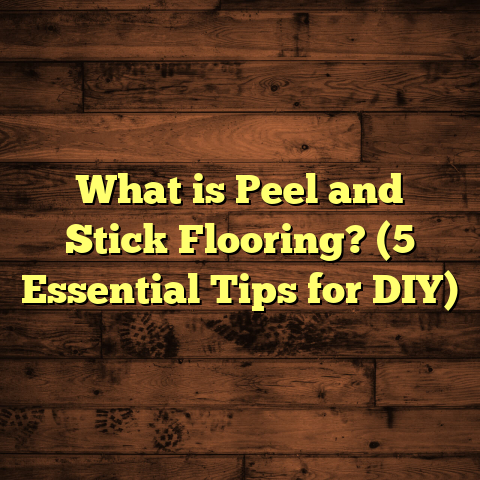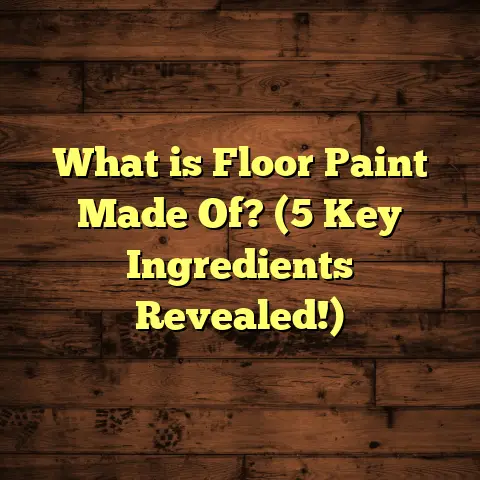What is a Sealed Hardwood Floor? (5 Benefits You Didn’t Know)
Have you ever wondered why some hardwood floors look flawless and stay that way for years, while others show scratches, stains, and wear so quickly? I’ve been in the flooring business for over a decade, and one of the key secrets to a lasting, beautiful hardwood floor is the finish—or more specifically, whether it’s sealed or not. Today, I want to share what a sealed hardwood floor really is and reveal five benefits that many homeowners don’t even realize.
What Is a Sealed Hardwood Floor?
When you hear “sealed hardwood floor,” what comes to mind? Maybe you picture shiny floors coated with some glossy substance. But really, the term “sealed” means much more than just appearance. A sealed hardwood floor is wood that’s been protected with a special coating or finish designed to create a barrier between the wood and the environment.
Wood is naturally porous, meaning it absorbs moisture, dirt, and oils. These elements can cause damage such as swelling, warping, staining, or discoloration over time. By sealing the wood, you close these pores and protect the surface from these harmful effects.
The Science Behind Sealing Hardwood Floors
Understanding the science helps explain why sealing works so well. Wood fibers are made of cellulose and lignin, which absorb moisture from the air or spills. This moisture causes the wood to expand, and when it dries, it contracts. Over time, this constant movement weakens the wood structure leading to cracks or warping.
Sealing puts down a protective layer—whether it’s polyurethane, varnish, wax, or oil—that stops moisture penetration. These sealants also add toughness by bonding tightly with the wood surface.
Types of Sealants Commonly Used
I’ve worked with many sealants over my career. Here are the main types:
- Polyurethane: The most common finish. Comes in water-based and oil-based forms. Durable and resistant to scratches.
- Varnish: Similar to polyurethane but tends to be more flexible and resistant to UV damage.
- Wax: Adds shine and enhances grain but requires frequent maintenance.
- Oil-based sealers: Penetrate deeper into wood fibers and bring out natural color but aren’t as hard-wearing on the surface.
- Aluminum oxide finishes: Often factory-applied on prefinished hardwood; extremely durable.
Each has pros and cons depending on where you use it (high traffic areas vs. bedrooms), how much maintenance you want to do, and your budget.
Manufacturing Process of Sealed Hardwood Floors
Most hardwood floors you buy come in two types: unfinished (requiring onsite finishing) or prefinished (factory-sealed before installation).
For unfinished floors:
- Sanding: The raw wood surface is sanded smooth.
- Cleaning: Dust and debris removed.
- Sealing: Multiple coats of sealant are applied on site.
- Curing: Each coat dries fully before applying the next.
Prefinished floors have their sealant applied during manufacturing under controlled conditions:
- Wood planks are cut and sanded.
- Sealants are sprayed or brushed on in multiple layers.
- UV curing systems speed up drying time.
- Finished boards are packaged for installation.
Factory finishing ensures consistent quality, while site finishing allows customization but requires more labor and time.
Benefit 1: Long-Lasting Protection Against Wear and Tear
One thing I always tell my clients is that hardwood floors get a ton of foot traffic—and without proper protection, they’ll show scratches and dents quickly.
Sealed hardwood floors offer a hard surface that resists abrasion.
How Does Sealing Increase Durability?
The sealant forms a tough outer shell that absorbs impacts and prevents direct contact with the wood beneath. For example, if you drop a heavy object on an unsealed floor, it could dent deeply; on a sealed floor, damage is often limited to the finish layer alone.
Here’s some data from manufacturers: floors sealed with polyurethane can handle 25% higher impact resistance compared to unsealed floors.
Real-Life Example: A Busy Daycare Center
I once installed sealed floors in a daycare center where spills and scuffs happen daily. After two years of heavy use, the floors still looked almost brand new.
Parents noticed less dirt buildup and fewer scratches despite kids running around with high energy. Staff appreciated how easy cleanup was.
Abrasion Resistance Testing
In lab tests simulating foot traffic, sealed hardwood floors show significantly less wear after thousands of cycles of abrasion compared to raw wood surfaces. This means your floor stays smooth without rough patches forming.
Benefit 2: Resistance to Moisture and Stains
Have you ever spilled coffee or juice on an unsealed wooden floor? If so, you know how fast it can soak in and leave ugly stains.
Why Does Sealing Help Against Moisture?
Wood fibers absorb liquids like a sponge unless sealed properly. The sealant acts like a waterproof shield.
According to tests by flooring companies:
- Sealed floors reduce water absorption by up to 90%.
- This dramatically cuts down risks of warping or cupping caused by moisture swelling fibers.
- Mold growth is minimized because damp wood is a breeding ground for fungi.
Case Study: Kitchen Spills and Pet Accidents
One client had young kids plus two dogs—accidents were inevitable. Their sealed oak floor survived multiple spills without discoloration or swelling. Cleanup was simple: wipe up messes quickly, and the seal prevented any permanent marks.
This experience highlights how sealing saves money long-term by avoiding repairs from water damage.
Benefit 3: Easier Maintenance and Cleaning
You may wonder: how much upkeep do sealed floors need?
Daily Cleaning Made Simple
Since sealed floors have a smooth, non-porous surface, dust and dirt don’t embed easily. Sweeping or vacuuming regularly keeps them looking fresh.
Mopping with a damp cloth using gentle wood floor cleaners works well—no harsh chemicals or scrubbing needed.
How Sealed Floors Resist Stains From Common Household Substances
Substances like oil from cooking or dirt from shoes often stain unsealed wood. Sealants prevent these from soaking in deep by blocking pores.
I remember a client who spilled red wine at their dinner party. Thanks to the sealant layer, cleanup was quick with no stain left behind.
Time Savings for Busy Homeowners
Many clients tell me they spend 30-40% less time cleaning sealed floors than those with untreated wood. This adds up over months and years.
Benefit 4: Enhanced Aesthetic Appeal
Sealing doesn’t just protect; it enhances your floor’s natural beauty.
How Sealants Affect Wood Appearance
Sealants penetrate slightly into the surface grain, enriching color tones and adding depth.
You can choose from finishes like:
- Glossy: Reflects light for a bright look.
- Satin: Soft sheen that’s elegant without shine.
- Matte: Natural-looking with minimal gloss.
Each finish changes how light interacts with wood grain patterns.
Personal Story: Walnut Floors That Transformed a Room
I installed sealed walnut flooring in a friend’s home office who wanted a warm atmosphere. After sealing, she was amazed at how much richer the colors became—the finish highlighted natural swirls in the grain that were barely visible before.
UV Protection in Sealants
Some modern sealants include UV blockers preventing sunlight from fading wood color over years. This means your floors stay vibrant even in sunlit rooms.
Benefit 5: Increased Home Value and Longevity
Hardwood floors are already popular for adding value to homes, but sealing takes it further.
Resale Value Boost
According to real estate experts:
- Homes with well-maintained hardwood floors sell for 2-5% more than comparable homes without.
- Buyers often see sealed floors as a sign of good home care.
- This can speed up sales and improve offers.
Longevity Through Protection
Sealing extends your floor’s life by protecting against damage that leads to expensive repairs or premature replacement.
I had a client who chose to restore their century-old hardwood rather than replace it. After sealing, their floors looked stunning again while gaining decades of additional life expectancy.
Deeper Look: Comparing Sealed vs Unsealed Hardwood Floors
You might ask: what happens if I skip sealing?
Unsealed Hardwood Floors
- High risk of moisture absorption leading to warping.
- Vulnerable to stains from spills.
- Easily scratched or dented.
- Require frequent sanding/refinishing.
- Can look dull or uneven due to dirt buildup.
Sealed Hardwood Floors
- Protected against water damage.
- Resistant to stains.
- Durable surface withstands foot traffic.
- Easier cleaning routines.
- Enhanced color and shine options.
How To Choose The Right Sealant For Your Hardwood Floor
Choosing the right sealant involves considering your lifestyle and priorities:
| Sealant Type | Durability | Appearance | Drying Time | Maintenance | Best For |
|---|---|---|---|---|---|
| Water-Based Polyurethane | High | Clear, non-yellowing | Fast (2-4 hours) | Low | Homes with kids/pets |
| Oil-Based Polyurethane | Very high | Warm amber tone | Longer (8-12 hours) | Moderate | Traditional aesthetics |
| Varnish | High | Glossy or satin | Moderate | Low | Outdoor decks/UV exposure |
| Wax | Low | Warm glow | Quick | High | Low traffic areas |
| Oil-Based Sealer | Moderate | Enhances grain | Moderate | Reapplication needed | Natural look preferred |
I always recommend water-based polyurethane for busy households due to its fast drying time and durability without yellowing.
Tips From My Experience For Maintaining Sealed Hardwood Floors
Even the best sealant needs some care:
- Use furniture pads: Prevent scratches from chairs or tables.
- Avoid standing water: Wipe spills promptly.
- Clean regularly: Sweep/vacuum frequently; mop lightly.
- Avoid harsh chemicals: Use pH-neutral cleaners designed for wood.
- Refinish when needed: Depending on wear, reseal every 7–10 years.
My Flooring Installations: Stories That Illustrate The Value of Sealed Floors
Case Study 1: High-Traffic Retail Store
A retail client wanted durable flooring that looked great after thousands of customers walked daily. We installed sealed maple floors with an aluminum oxide finish factory-applied for maximum toughness.
After a year, their floors showed minimal wear; cleaning was fast; customers complimented the shop’s warm atmosphere created by the wood flooring.
Case Study 2: Historic Home Restoration
In restoring an 1800s home, we preserved original oak floors by sanding and sealing with oil-based finishes to maintain authentic appearance but add protection against modern-day living challenges like pets and kids.
The owners were thrilled that their floors kept historical integrity while gaining modern durability.
What Makes Sealed Hardwood Floors A Smart Investment?
Let me break it down:
- Durability: Protects your floor from daily hazards.
- Appearance: Keeps your home looking polished and warm.
- Ease of Cleaning: Saves time on chores.
- Moisture Resistance: Prevents costly water damage repairs.
- Value Addition: Boosts resale price of your home.
From my years installing thousands of square feet of hardwood flooring, sealing isn’t just an extra step—it’s fundamental for making sure your investment lasts decades without losing charm or function.
Frequently Asked Questions About Sealed Hardwood Floors
Q: Can I seal my existing hardwood floor myself?
A: Yes! Many DIYers do it successfully if they follow proper sanding and application steps carefully. However, professional installation ensures even coats and fewer mistakes.
Q: How long does sealing last?
A: Depending on foot traffic and maintenance, sealants typically last 7–10 years before recoating is recommended.
Q: Will sealing change the color of my wood?
A: Some sealants enhance color slightly; water-based finishes tend not to yellow over time unlike oil-based ones which add warmth.
Q: Is sealing necessary for engineered hardwood?
A: Prefinished engineered hardwood usually comes factory-sealed; additional sealing isn’t required unless refinishing onsite later.
Final Thoughts: Your Next Steps Toward Beautiful Hardwood Floors
If you want floors that look great year after year without extra hassle, sealing is non-negotiable. It guards your investment while bringing out the natural beauty of wood like nothing else can.
Thinking about getting your floors sealed? I can help answer questions about which products suit your space best or assist with professional application advice tailored to your budget and style preferences.
Trust me—once you experience how sealed hardwood floors transform your home’s look and durability, you’ll never want anything else beneath your feet!
If you want me to help calculate potential costs or find local contractors who specialize in sealing hardwood floors professionally, I use tools like FloorTally regularly—just let me know!





